
mercoledì 21 novembre 2018, h.16.30
Facoltà di Architettura. Aula Magna.
Piazza Fontanella Borghese
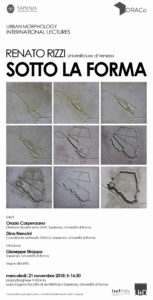
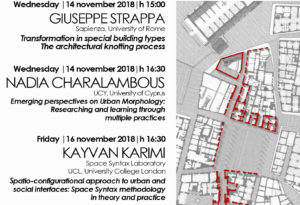
07 NOVEMBER h. 16,30
VITOR OLIVEIRA
The historico-geographical approach to urban morphology: theories, concepts and methods’.
14 NOVEMBER h. 15,00
GIUSEPPE STRAPPA
Transformation of special building types. The process of architectural knotting
14 NOVEMBER h. 16,30
NADIA CHARALAMBOUS
Emerging Perspectives on Urban Morphology: Researching and Learning through Multiple Practices
16 NOVEMBER h. 16,30
KAYVAN KARIMI
Spatio-configurational approach to urban morphology and social interfaces: Space Syntax methodology in theory and practice
ХХV International Seminar on Urban Form 2018
Urban Form and Social Context: from traditions to newest demands
Conference Dates:
July 5, 2018 – July 9, 2018
http://conf.sfu-kras.ru/en/isuf2018
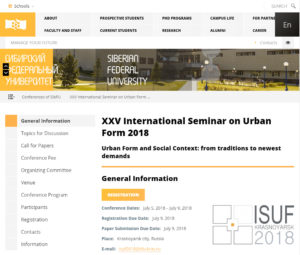
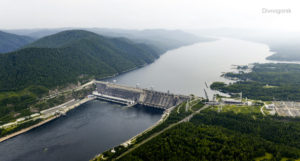
Topics for Discussion
Urban morphological theory
Urban morphological methods and techniques
The evolution of urban form under the social influence
Urban form and technology
Fringe belts, development within the newest demands
Historical urban fabric
Urban landscape: history and socio-cultural transformations
Architectural typology: history, development, tendencies
Urban identity
Urban morphology, regeneration and newest urban design
Cartogpaphy data
Tools of analysis
PSUF – post socialist urban form
Teaching Urban Morphology
New Researchers Forum
Organizing Committee
ОРГКОМИТЕТ
Международной конференции XXV ISUF «Форма города и социальный контекст: от традиций к требованиям современности» (“Urban Form and Social Context: from traditions to newest demands”)
5-9 июля 2018 г.
1. Barke, Michael. Northumbria University, (UK), emeritus professor of Urban Sociology, член Ученого комитета международной ассоциации урбо- морфологов,
2. Conzen, Michael P. University of Chicago (USA), professor of Geography, один из основателей англо-немецкой школы урбоморфологии, член Ученого комитета международной ассоциации урбо- морфологов,
3. Colomer, Vicente Universitat Politècnica de València (Spain), professor, член Ученого комитета международной ассоциации урбо- морфологов,
4. Gu, Kai. University Auckland (New Zealand), associate professor, director Urban Planning programs, Ученый секретарь международной ассоциации Urban Morphology
5. Kantarek, Anna Agata professor, Politechnika Krakowska, Kraków, Poland, член Ученого комитета международной ассоциации урбо- морфологов,
6. Marat-Mendes Teresa, ISCTE -IUL – University Institute of Lisbon (Portugal), associate professor, School of Architecture and Urbanism, член Ученого комитета международной ассоциации урбо- морфологов,
7. McClure Wendy, University of Idaho (USA), professor in Architecture, член Ученого комитета международной ассоциации урбо- морфологов,
8. Oliveira, Vítor. University of Porto (Portugal), professor of Urban Morphology and Urban Planning at ULP and Senior Researcher at the Research Centre for Territory Transports and Environment (FEUP), член ученого комитета международной ассоциации урбо- морфологов,
9. Samuels Ivor, University of Birmingham (UK), School of Geography, Earth and Environmental Sciences, Honorary Senior Research Fellow, член Ученого комитета международной ассоциации урбо- морфологов,
10. Scheer, Brenda Case, professor University of Utah, USA, член Ученого комитета международной ассоциации урбо- морфологов,
11. Strappa, Giuseppe, professor, Sapienza – Università di Roma, Italy, член Ученого комитета международной ассоциации урбо- морфологов,
12. Whitehand, Jeremy. University of Birmingham (UK), emeritus professor of Urban Geography, главный редактор журнала Urban Morphology, член Ученого комитета международной ассоциации урбо- морфологов
Université Laval du Québec
EXPOSITION Lecture morphologique des espaces
d’échange et commerce dans la Ville de Québec
lundi 16 avril 2018,13h30, salle 1224
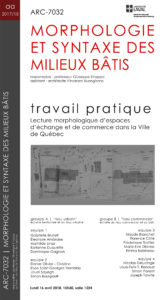
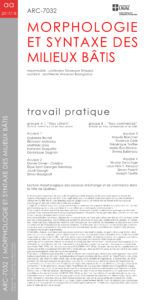
La transformation radicale des espaces dédiés au commerce est l’un des phénomènes qui a le plus contribué à la condition de la métropole contemporaine. C’est un phénomène tout à fait nouveau qui s’est développé à partir du deuxième après-guerre dans les grandes villes nord-américaines et qui a progressivement investi toutes les grandes villes, constituant l’un des aspects les plus évidents de la globalisation. Leur concentration extrême a généré de nouveaux types de tissus spécialisés non liés au bâti de base, isolés par des grands parkings, caractérisés par la relation physique toujours plus faible entre le vendeur et l’acheteur. Dans ces tissus l’espace est reconnu comme isotrope, non orienté, où l’acheteur se déplace sans but et où prennent de l’importance les espaces résiduels. De l’autre côté, avec la réduction des échanges commerciaux due à la concentration dans les structures spécialisées, les tissus traditionnels perdent l’une de leurs composantes les plus importantes. À l’échelle urbaine le grand shopping district, situé dans des zones marginales, est considéré comme un lieu en constante transformation. Il accueille une partie importante de la vie de la ville, mais il ne génère pas d’identité, ni d’appartenance, ni d’espaces communs. A l’échelle du bâti, les structures de vente sont composées d’ensembles d’éléments en série distribués par un parcours interne ou externe, polarisé par des “attracteurs”, relativement homogènes et indifférents au type de produit……
affiche_expocritiqueMorphoArc7032
.http://www.giuseppestrappa.it/wp-content/uploads/2018/04/affiche_expocritiqueMorphoArc7032.pdf